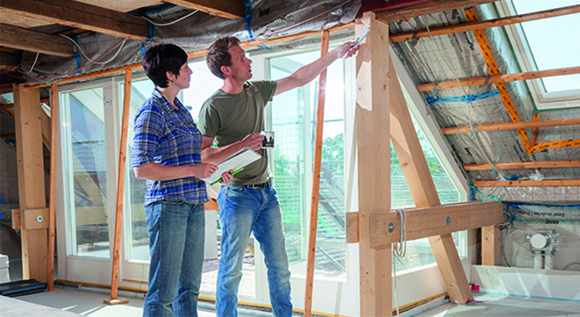The energy transition in German homes – the time is now!
From August onwards, the Federal Government will be providing even more financial assistance for energy-efficient retrofitting measures.
 © BMWi/Holger Vonderlind
© BMWi/Holger Vonderlind
Almost 40 per cent of Germany’s final energy consumption is used in buildings – mostly for heating and hot water. The bulk of Germany’s 18 million residential buildings were built before 1979 – which often means poor energy efficiency. But there is huge potential to save energy in these buildings.
Leveraging this potential is now becoming even more worthwhile for home owners thanks to improved public funding programmes. It does not matter whether you are planning a complete modernisation or want to improve a building’s energy efficiency step-by-step, e.g. by installing a modern heating system or new energy-efficient windows; every single measure counts when making energy saving improvements to the home. They will not only result in lower costs for heating and hot water, but also in lower carbon emissions, thereby making a contribution to climate mitigation.
This is why the "Energy-efficient refurbishment" funding programme run by KfW, a state promotional bank, will become even more attractive from 1 August 2015 onwards. Both the low-interest loan and the investment grant funding models will be improved.
Both funding models improved
When it comes to the low-interest loan, the maximum amount awarded for refurbishments to meet “KfW Efficiency House” standards – which means energy standards that are above the legal minimum – will be increased to 100,000 euros from 1 August. As a result, an additional 25,000 euros can be borrowed at a reduced interest rate (currently 0.75 per cent annually). Depending on the energy efficiency standard achieved, you may not have to pay back the loan in full. This is because the loan comes with what is known as a repayment bonus which is currently fixed at 22.5 per cent and will be increased by up to 27.5 per cent of the loan amount.
Another improvement is the introduction of a repayment bonus covering 7.5 per cent of the loan for individual energy efficiency measures, if they are funded using a KfW loan. This encourages home owners to start making energy saving improvements at home, even if they don’t have enough money for a complete modernisation. Experience gathered over the years has shown that many home owners prefer to improve energy efficiency at home step by step in order to spread the costs over several years.
The investment grant, intended for investors who do not use a KfW loan, will also see its conditions improve. The state will now pay up to 30% of the investment costs for having one-family or two-family homes retrofitted to make them more energy efficient – that is 5 per cent more than in the past. The maximum grant per residential unit will be raised from 18,750 euros to 30,000 euros.
Funding now available for retrofitting newer buildings
The KfW’s "Energy-efficient refurbishment" programme is now also available for newer buildings. So far, it has only been available for older buildings that were built before 1 January 1995. Now, buildings that were built in the more recent past will be eligible for funding to improve their energy performance. All residential buildings for which a building application was submitted or the start of construction was notified before 1 February 2002 are eligible for funding.
Before you start to make energy saving improvements, you should get energy-related advice on planning and construction from an expert. If you use the services of a qualified energy expert, you can apply for an additional grant of up to 4,000 euros.
A success story
The KfW funding programmes for energy-efficient construction and retrofitting, funded by the Federal Government as part of its CO2 Building Modernisation Programme, have become part and parcel of the energy transition over the past few years. One in three retrofits and half of all new-builds benefit from these funding programmes, and go on to raise energy efficiency standards above what is legally required.
This is a real success story and can be seen in these impressive figures from 2006 to 2014: more than 3.8 million homes were upgraded in terms of their energy performance or were newly built using the funding programmes. Furthermore, in 2007, funding was awarded for more than 2,150 municipal and social service buildings in order to make them more energy efficient. A total of around 190 billion euros was invested to improve the energy efficiency of buildings, cutting carbon emissions by more than 7.6 million tonnes per year.
Benefits for both tenants and landlords
KfW’s "Energy-efficient refurbishment" programme relieves the burden on both tenants and landlords by cushioning the additional costs incurred due to investments in improving the energy efficiency of buildings. These investments have two long-term benefits. Firstly, they keep running costs low in the long term, and secondly they make owners and tenants less vulnerable to rising energy prices.

